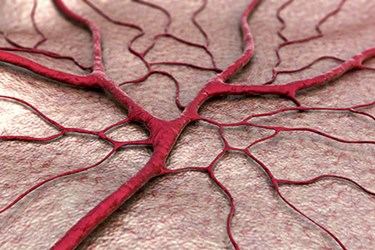Researchers Develop New Material To Make Artificial Blood Vessels

Researchers have developed a new artificial blood vessel made from a special elastomer material that they say is stronger than existing technology. The team has achieved early success on animal studies and hopes to soon move into human trials.
Traditionally, heart bypass surgeries have involved harvesting blood vessels from another part of the patient’s body and grafting the vessel around a blockage. However, advanced vascular disease can limit surgeon’s options of where to locate a suitable graft.
In recent years, scientists have been developing artificial blood vessels made from synthetic materials that are designed to encourage tissue regeneration. Research suggests that a patient could grow their own blood vessel as the synthetic vessel safely dissolved, and this approach could cut down on many complications caused by traditional methods.
According to a research team in Austria, which includes scientists from Vienna University of Technology (TU Wein) and Medical University of Vienna (MUV), the development of a degradable blood vessel prostheses requires a material that provides adequate biomechanical strength and biocompatibility while promoting host tissue regeneration.
In a study published in Acta Biomaterialia, the authors noted, “Current approaches often reveal limited tensile strength and therefore require thicker or reinforced graft walls.” Researchers said that the inflexibility and small size of these materials often caused them to become blocked.
To solve this problem, the team synthesized a polymer from a solution of thermoplastic polyurethanes that were electrospun to form a very thin thread.
“By selecting very specific molecular building blocks, we have succeeded in synthesizing a polymer with the desired properties,” said Robert Liska, a scientist from TU Wein, in a MUV press release.
Heinz Schima, a scientist from MUV, added that the structure of these synthetic vessels was very similar to natural blood vessels.
According to the researchers, the polymer fabric is initially a little porous, and this allows blood to flow into its structure, a process that enriches the wall with growth factors and encourages the migration of endogenous cells.
The team implanted their design into rats and found that their new method was very well tolerated.
“The rats’ blood vessels were examined six months after insertion of the vascular prostheses. We did not find any aneurysms, thrombosis or inflammation. Engogenous cells had colonized the vascular prostheses and turned the artificial constructs into natural body tissue,” said Helga Bergmeister of MUV.
Scientists noted that because the new vessels grew so quicky, they may be able to adjust the material to dissolve even faster. Further preclinical adjustments are in the works, and the team hopes to start human trials with the material within the next few years.
Image Credit: “Circulatory System.” Eric Villalba. 2012 CC BY 2.0: https://creativecommons.org/licenses/by/2.0/
